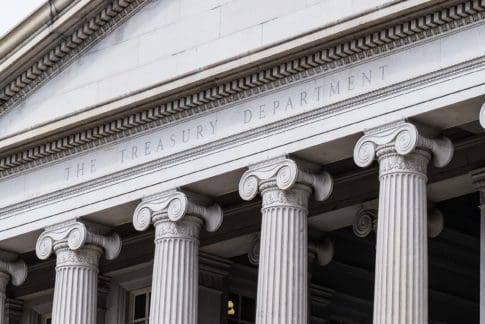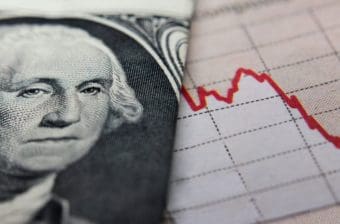View an update to this piece here.
Once again, the debt ceiling is in the news and a cause for concern. If the debt ceiling binds, and the US Treasury does not have the ability to pay its obligations, the negative economic effects would quickly mount and risk triggering a deep recession.
The debt limit caps the total amount of allowable outstanding US federal debt. The US hit that limit—$31.4 trillion—on January 19, 2023, but the Department of the Treasury has been undertaking a set of “extraordinary measures” so that the debt limit does not yet bind. The Treasury estimates that those measures will be sufficient at least through early June. Sometime after that, unless Congress raises or suspends the debt limit before June, the federal government will lack the cash to pay all its obligations. Those obligations are the result of laws previously enacted by Congress. As our colleagues Len Burman and Bill Gale wrote in a recent Brookings piece, “Raising the debt limit is not about new spending; it is about paying for previous choices policymakers.”
The economic effects of such an unprecedented event would surely be negative. However, there is an enormous amount of uncertainty surrounding the speed and magnitude of the damage the US economy will incur if the US government is unable to pay all its bills for a time—it depends on how long the situation lasts, how it is managed, and the extent to which investors alter their views about the safety of US Treasuries. An extended impasse is likely to cause significant damage to the US economy. Even in a best-case scenario where the impasse is short-lived, the economy is likely to suffer sustained—and completely avoidable—damage.
“Even in a best-case scenario where the impasse is short-lived, the economy is likely to suffer sustained—and completely avoidable—damage.”
The US government pays a lower interest rate on Treasury securities because of the unparalleled safety and liquidity of the Treasury market. Some estimates suggest that this advantage lowers the interest rate the government pays on Treasuries (relative to interest rates on the debt of other sovereign nations) on the order of 25 basis points (a quarter of a percentage point) on average. Given the current level of the debt, this translates into interest savings for the federal government of roughly $60 billion this year and more than $800 billion over the next decade. If a portion of this advantage were lost by allowing the debt limit to bind, the cost to the taxpayer could be significant.
How will the US Treasury operate when the debt limit binds?
One cannot predict how Treasury will operate when the debt limit binds, given that this would be unprecedented. Treasury did have a contingency plan in place in 2011 when the country faced a similar situation, and it seems likely that Treasury would follow the contours of that plan if the debt limit were to bind this year. Under the plan, there would be no default on Treasury securities. Treasury would continue to pay interest on those Treasury securities as it comes due. And, as securities mature, Treasury would pay that principal by auctioning new securities for the same amount (and thus not increasing the overall stock of debt held by the public). Treasury would delay payments for all other obligations until it had at least enough cash to pay a full day’s obligations. In other words, it will delay payments to agencies, contractors, Social Security beneficiaries, and Medicare providers rather than attempting to pick and choose which payments to make that are due on a given day.
Timely payments of interest and principal of Treasury securities alongside delays in other federal obligations would likely result in legal challenges. On the one hand, the motivation to pay principal and interest on time to avoid a default on Treasury securities is clear; on the other, lawsuits would probably argue that holders of Treasury securities have no legal standing to be paid before others. It is not clear how such litigation would turn out, as the law imposes contradictory requirements on the government. Treasury is required to make payments, honor the debt, and not go above the debt limit: three things that cannot all happen at once.
Treasury may have the legal authority to mint and issue a “collectible” trillion-dollar platinum coin and deposit it at the Federal Reserve in exchange for cash to pay the government’s bills. However, Treasury Secretary Janet Yellen noted recently that the Fed, reluctant to intervene in a partisan political dispute, might not accept the deposit. Others argue that the 14th Amendment to the Constitution—which says that “the validity of the public debt of the United States … shall not be questioned”—would allow the Treasury to ignore the debt limit. But those actions would certainly be viewed as circumventing the law that establishes the debt ceiling, and they would likely not prevent havoc in the debt market and many of the ill effects on the economy described below.
How much would non-interest federal spending have to be cut?
If the debt limit binds, and the Treasury were to make interest payments, then other outlays will have to be cut in an average month by about 20 percent. That would be necessary because over this period as a whole, the Congressional Budget Office expects close to 20 cents of every dollar of non-interest outlays to be financed by borrowing. However, the size of the cuts would vary from month to month because infusions of cash to the Treasury from tax revenues vary greatly by month. Tax revenues in July and August tend to be fairly muted. Thus, the required cuts to federal spending when an increase in federal debt is precluded are particularly large during these months. If Treasury wanted to be certain that it always had sufficient cash on hand to cover all interest payments, it might need to cut non-interest spending by 35 percent or more.
How would a binding debt limit affect the economy?
The economic costs of the debt limit binding, while assuredly negative, are enormously uncertain. Assuming interest and principal is paid on time, the very short-term effects largely depend on the expectations of financial market participants, businesses, and households. Would the stock market tumble precipitously the first day that a Social Security payment is delayed? Would the US Treasury market, the world’s most important, function smoothly? Would there be a run on money market funds that hold short-term US Treasuries? What actions would the Federal Reserve take to stabilize financial markets and the economy more broadly?
Much depends on whether investors would be confident that Treasury would continue paying interest on time and on how long they think the impasse will persist. If people expect the impasse will be short-lived and are certain that the Treasury will not default on Treasury securities, it is possible that the initial response could be muted. However, that certainty would in part depend on whether there are swift legal challenges to the Treasury prioritizing interest payments and subsequent rulings.
Regardless, even if the debt limit were raised quickly so that it only was binding for a few days, there could be lasting damage. At the very least, financial markets would likely anticipate such disruptions each time the debt limit nears in the future. In addition, the shock to financial markets and loss of business and household confidence could take time to abate.
If the impasse were to drag on, market conditions would likely worsen with each passing day. Concerns about a default would grow with mounting legal and political pressures as Treasury security holders were prioritized above others to whom the federal government had obligations. Concerns would grow regarding the direct negative economic effects of a protracted sharp cut in federal spending.
Worsening expectations regarding a possible default would make significant disruptions in financial markets increasingly probable. That could result in an increase in interest rates on newly-issued Treasuries. If financial markets started to pull back from US Treasuries all together, the Treasury could have a difficult time finding buyers when it sought to roll over maturing debt, perhaps putting pressure on the Federal Reserve to purchase additional Treasuries in the secondary market. Such financial market disruptions would very likely be coupled with declines in the price of equities, a loss of consumer and business confidence, and a contraction in access to private credit markets.
Financial markets, businesses, and households would become more pessimistic about a quick resolution and increasingly worried that a recession was inevitable. More and more people would feel economic pain because of delayed payments. Take just a few examples: Social Security beneficiaries seeing delays in their payments could face trouble with expenses such as rent and utilities; federal, state, and local agencies might see delays in payments that interrupt their work; federal contractors and employees would face uncertainty about how long their payments would be delayed. Those and other disruptions would have enormous economic and health consequences over time.
Given that those disruptions would likely occur when the economy is growing slowly and perhaps contracting, the risk that the crisis would quickly trigger a deep recession is heightened. Moreover, tax revenues, the only resource the Treasury would have to pay interest on the debt, would be dampened, and the federal government would have to cut back on non-interest outlays with increasing severity.
In a worst-case scenario, at some point Treasury would be forced to delay a payment of interest or principal on US debt. Such an outright default on Treasury securities would very likely result in severe disruption to the Treasury securities market with acute spillovers to other financial markets and to the cost and availability of credit to households and businesses. Those developments could undermine the reputation of the Treasury market as the safest and most liquid in the world.
Estimates of the effects of a binding debt limit on the US economy
It is obviously difficult to quantify the effects of a binding debt limit on the macroeconomy. However, history and illustrative scenarios provide some guidance.
Evidence from prior “near-misses”:
As discussed in this Hutchins Center Explains post, when Congress waited until the last minute to raise the debt ceiling in 2013, rates rose on Treasury securities scheduled to mature near the projected date the debt limit was projected to bind—by between 21 basis points and 46 basis points, according to an estimate from Federal Reserve economists—and liquidity in the Treasury securities market contracted. Yields across all maturities also increased a bit as well, according to the Federal Reserve economists’ study—by between 4 basis points and 8 basis points—reflecting investors’ fears of broader financial contagion. Similarly, after policymakers came close to the brink of the debt limit binding in 2011, the GAO estimated that the delays in raising the debt limit increased Treasury’s borrowing costs by about $1.3 billion that year. The fact that the estimated effects are small in comparison to the US economy likely reflects that investors didn’t think it very likely that the debt ceiling would actually bind and thought that if it did, the impasse would be very short-lived.
Evidence from macroeconomic models:
In October 2013, the Federal Reserve simulated the effects of a binding debt ceiling that lasted one month—from mid-October to mid-November 2013—during which time Treasury would continue to make all interest payments. The Fed economists estimated that such an impasse would lead to an 80 basis point increase in 10-year Treasury yields, a 30 percent decline in stock prices, a 10 percent drop in the value of the dollar, and a hit to household and business confidence, with these effects waning over a two-year period. According to their analysis, this deterioration in financial conditions would result in a mild two-quarter recession, leading to an increase in the unemployment rate of 1.25 percentage points and 1.7 percentage points over the following two years. Such an increase in the unemployment rate today would mean the loss of 2 million jobs in 2022 and 2.7 million jobs in 2023.
Macroeconomic Advisers conducted a similar exercise in 2013. It assessed the economic costs of two scenarios—one in which the impasse lasted just a short time and another in which it persisted for two months. Even in the scenario in which the impasse was resolved quickly, the economic consequences were substantial—a mild recession and a loss of 2.5 million jobs that returned only very slowly. For the two-month impasse, which included a deep cut to federal spending in one quarter, offset by a surge in spending in the next quarter, the effects were larger and longer lasting. In the analysis, such a scenario would lead to the near-term loss of up to 3.1 million jobs. Even two years after the crisis, there would be 2.5 million fewer jobs than there otherwise would have been.
In 2021, when an impasse among policymakers once again threatened Treasury’s ability to pay its obligations, Moody’s Analytics concluded that the costs to the US economy of allowing the debt limit to bind then would be severe. In Moody’s simulation, if the impasse lasted several months in the fall of 2021, employment would decline by 5 million and real GDP would decline almost 4 percent in the near term before recovering over the next few quarters.
Conclusion
While greatly uncertain, the effects of allowing the debt limit to bind could be quite severe, even assuming that principal and interest payments continue to be made. If instead the Treasury fails to fully make all principal and interest payments—because of political or legal constraints, unexpected cash shortfalls, or a failed auction of new Treasury securities—the consequences would be even more dire.
The workarounds that have been proposed—the platinum coin, borrowing anyway, prioritizing payments—either bring significant legal uncertainty or are not sustainable solutions. These unlikely workarounds do not avoid the chaos that is inherent to the debt ceiling binding. The only effective solution is for Congress to increase the debt ceiling or, better yet, abolish it.



